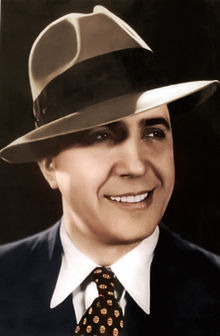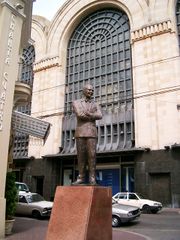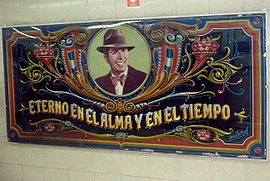Carlos Gardel
| Carlos Gardel | |
|---|---|
 Carlos Gardel (1933) |
|
| Background information | |
| Born | December 11, 1887? Tacuarembó, Uruguay / 1890? Toulouse, France |
| Died | June 24, 1935 Medellín, Colombia |
| Genres | Tango |
| Years active | 1917-1935 |
Carlos Gardel (11 December 1887/18901 - 24 June 1935) was a singer, songwriter and actor, and is perhaps the most prominent figure in the history of tango. Although his birthplace is disputed between Argentina, Uruguay and France, he lived in Argentina from the age of two and acquired Argentine citizenship in 1923. He grew up in the Abasto neighbourhood of Buenos Aires, located near the Central Market of Fruit and Vegetables, an enormous art-deco styled building which today is a shopping mall. He attended Pio IX Industrial high-school located in the Almagro neighbourhood. He died in an airplane crash at the height of his career, becoming an archetypal tragic hero mourned throughout Latin America. For many, Gardel embodies the soul of the tango style that originated in the barrios of Buenos Aires at the end of the 19th century. He is commonly referred to as “Carlitos”, “El Zorzal” (The Song Thrush), “The King of Tango”, “El Mago” (The Magician) and “El Mudo” (The Mute).
The unerring musicality of Gardel’s baritone voice and the dramatic phrasing of his lyrics made miniature masterpieces of his hundreds of three-minute tango recordings. Together with lyricist and long-time collaborator Alfredo Le Pera, Gardel wrote several classic tangos, most notably: Mi Buenos Aires querido, Cuesta abajo, Amores de estudiante, Soledad, Volver, Por una cabeza and El día que me quieras.
Contents |
Career

Gardel began his singing career in bars and at private parties, and sang with Francisco Martino and later in a trio with Martino and José Razzano. Gardel created the tango-canción in 1917 with his rendition of Pascual Contursi and Samuel Castriota’s Mi Noche Triste. The recording sold 10,000 copies and was a hit throughout Latin America. Gardel went on tour through Argentina, Uruguay, Chile, Brazil, Puerto Rico, Venezuela, Colombia, and also made appearances in Paris, New York, Barcelona and Madrid. He sold 70,000 records in the first three months of a 1928 visit to Paris. As his popularity grew, he made a number of films for Paramount in France and the U.S. While sentimental films such as El día que me quieras and Cuesta abajo lack lasting dramatic value, they were outstanding showcases of his tremendous singing talents and moviestar looks.
In 1915 Carlos Gardel was supposedly wounded after being shot by Che Guevara’s father, Ernesto Guevara Lynch, as a result of a bar room brawl in the belle epoque Palais de Glace in the Recoleta district of Buenos Aires, although different versions assert that he was shot in the chest or in the leg, yet another variation holds that it was not Che’s father but rather Roberto Guevara, an upper-class boy often involved in quarrels.[1]
Death and ongoing profile
Gardel died in 1935 in an airplane crash in Medellín, Colombia. Le Pera, two of their guitarists (Guillermo Desiderio Barbieri and Ángel Domingo Riverol) and several business associates and friends of the group died in the crash as well.[2] It is believed that a third guitarist, José María Aguilar, died a few days after the crash.[2] Others state that Aguilar lived until 1951, although he never regained full use of his hands and sight.[3][4]
Millions of his fans throughout Latin America went into mourning. Hordes came to pay their respects as his body was taken from Colombia through New York and Rio de Janeiro. Thousands rendered homage during the two days he lay in state in Montevideo, the city in which his mother lived at the time. Gardel’s body was laid to rest in La Chacarita Cemetery in Buenos Aires. In the neighborhood of Abasto, Buenos Aires, in the house where Gardel lived with his mother, the Carlos Gardel Museum opened in 2003.
Gardel is still revered from Tokyo to Buenos Aires. A popular saying in Latin America, which serves as a testimony to his long-lived popularity, claims, “Gardel sings better every day.” The fingers of his life-sized tuxedo-clad statue on his tomb nearly always hold a burning cigarette left by an admirer. Another commonly used phrase in Latin America, which asserts that Veinte años no es nada (Twenty years is nothing), comes from his song Volver.
Statues in Scotland
During 2009/2010 statues depicting Gardel are scheduled to be erected temporarily throughout twenty-five small villages and towns of Scotland, commemorating his tour of 1930 where the singer used funds from his well paid appearances in Glasgow and Edinburgh to subsidise small unannounced concerts in rural venues. These impromptu (and free) appearances endeared him to the working population of Scotland and his legacy of passion and art endure through regular commemorative concerts and amateur productions. However the tour is a stunt carried out by performing arts company Mischief La Bas.
Birthplace controversy

The place of Gardel’s birth is a matter of considerable controversy that still provokes passionate debate in Uruguay and Argentina.[5]
During his life, Gardel declared in several occasions being Uruguayan, born in Tacuarembó. After his death, his legal representative, Armando Defino, produced a handwritten will, which he assured was written by Gardel himself, claiming he was born in Toulouse, France, to Berthe Gardès (1865–1943), and baptized with the name of Charles Romuald Gardes.[6]. The book has not been translated into English.</ref> It is not known who Gardel's father was. Because this will was officially considered authentic under Argentinian law, Berthe Gardes (and, after her, Defino himself) received Gardel's inheritance. There is an original birth certificate of a child born in Toulouse to Berthe Gardès on December 11, 1890. There is no other evidence (except for the handwritten will) linking this child with the singer. The will was controversial due to the lack of previous public notice that Gardel had any relationship with France whatsoever. He never publicly declared or suggested that during his life.
A different line of research (Payssé González: "Gardel. Páginas Abiertas", 1st. ed. Montevideo, 1990, 3rd. ed. Montevideo, 2002; Ostuni, "Repatriación de Gardel", Buenos Aires, 1997; Bayardo, "Carlos Gardel: A La Luz De La Historia", Montevideo, 2000) claims that Gardel was born Carlos Escayola Oliva in the rural estate ("estancia") of Carlos Escayola Medina, in the Uruguayan department of Tacuarembó. Gardel obtained his first official identity document ("Constancia de nacionalidad") in Buenos Aires on October 8, 1920. There, Gardel claims being Uruguayan, born in Tacuarembó to "Carlos and María, deceased". All the following official documents issued to Gardel certify he is Uruguayan. They can be seen here: http://www.montevideo-tango.com/mvdt/Gardel.htm. There is speculation that Gardel gave Tacuarembó as his birthplace to evade military service during World War I for his native France. Nevertheless, World War I ended in 1918, and this document was issued in 1920. It has been proven by Paysse Gonzalez (2002) and Bayardo (2000) that French law did not enforce military service to the sons of widows resident abroad.
When asked about his nationality, Gardel would repeatedly answer he was Uruguayan, born in Tacuarembó. To the periodical "El Telégrafo" (Paysandú, Uruguay, October 25, 1933) he declared: "I'm Uruguayan, born in Tacuarembó" [“soy uruguayo, nacido en Tacuarembó”]. In June's 1935 issue of "Caretas" magazine of Antioquia, Colombia, Gardel declared: "My heart is Argentinian, but my soul is Uruguayan, because there is where I was born“ ["Mi corazón es argentino, pero mi alma es uruguaya, porque allí nací”]. Several documents related with the theory that he is Uruguayan can be found here http://sites.google.com/site/eluruguayocarlosgardel/ [originals and website in Spanish]
Legacy
In literature
Gabriel García Márquez mentions Gardel in his novel, Love in the Time of Cholera. When Florentino Ariza and doctor Juvenal Urbino meet at the former's office in the Caribbean Fluvial Company, doctor Urbino unexpectedly asks Ariza, "Do you like music?". After seriously thinking the issue, Ariza answers, "I like Gardel."
Jorge Luis Borges, Julio Cortázar, Ernesto Sábato and Jimmy Buffett also mention Gardel in their works.
In film
There are two films about Gardel, both in production as of March 2009: Gardel 2008 (July 2009), starring Gael Garcia Bernal as Gardel,[7] and Dare to Love Me (2010).[8]
Dare To Love Me
In July 2003 Warner Brothers announced that they were working on a film version of Gardel's biography, The Vision of Love (the original cast included Jessica Alba, Ricardo Chavira and Halle Berry), but production was postponed in spring 2005 until early 2006, by that time both Alba and Chavira had backed out of the film. In 2007, Lindsay Lohan and Raoul Bova where cast in the lead roles of Gardel and La Ritana. It was left unknown when production would begin up until autumn 2008, when it was officially announced that production is set to begin on the film on 18 May 2009 and it will be released in late 2010.[8]
In the restaurant scene of the movie Scent of a Woman, Al Pacino dances with a woman to the tango Por Una Cabeza, written by Gardel and Alfredo Le Pera.
Popular culture
Gardel is mentioned in the song Sociedade Alternativa, by Brazilian rock artist Raul Seixas, in the lines se eu quero e você quer/tomar banho de chapéu/ou discutir Carlos Gardel (if we both want/to take a shower wearing hats/or to discuss Carlos Gardel).
In Tango Culture
Because the last song that Carlos Gardel performed before his death was "Adios Muchachos", the song came to be seen as a bad omen. In a proper milonga, it is taboo to play this song, or to use this phrase as a farewell.
Filmography
- Flor de Durazno (1917) (silent). This was Gardel's first film and was directed by Francisco Defilippis Novoa and was made in collaboration with Celestino Petray.[9]
- Luces de Buenos Aires (1931) (filmed in Paris)
- Esperame (1932)
- La Casa es seria (1932)
- Melodía de Arrabal (1932)
- Cuesta abajo (1934)
- El Tango en Broadway (1934)
- El Día que me quieras (1935)
- Cazadores de estrellas (1935)
- Tango Bar (1935)
References
- ↑ Un balazo mudo (In Spanish)
- ↑ 2.0 2.1 Clavell, M. (1996), Biografía. In: Los Mejores Tangos de Carlos Gardel. Alfred Publ. Van Nuys, California.
- ↑ Un hombre que nos evoca a Gardel prolonga en vida los resplandores de la tregedia en Medellín (In Spanish) Originally published in ANTENA 1950
- ↑ Carlos Gardel & his eight Guitarists
- ↑ Gardel Biografía web page
- ↑ The 2006 book by Juan Carlos Esteban, entitled Carlos Gardel Sus Antecedentes Franceses and published in Buenos Aires documents Gardel's 1890 birth in Toulouse, France as Charles Romuald Gardes. (Author's web page)
- ↑ IMDB profile page for Gardel 2008
- ↑ 8.0 8.1 IMDB profile page for Dare to Love Me
- ↑ Julián y Osvaldo Barsky (2004), Gardel la biografía, Taurus.
External links
![]() Spanish Wikiquote has quotations related to: Carlos Gardel
Spanish Wikiquote has quotations related to: Carlos Gardel
- Carlos Gardel at the Internet Movie Database
- Carlos Gardel at cinenacional.com
- www.gardelbiografia.com.ar (Spanish)
- Chronicles
- Carlitos
- / Carlos Gardel at Allmusic
- Gardel.us
- Carlos Gardel’s Gravesite
- Gardel Web (Spanish)
- History (Spanish)
- Documents of Carlos Gardel (Spanish)
- 'The true story about Gardel’s place of birth' (Spanish)
- 'Gardel'
- 'Carlos Gardel - biography and music' {{country data {{{1}}}
| flaglink/core | variant = | size = | name = | altlink = national rugby union team | altvar = rugby union }}
|
||||||||
